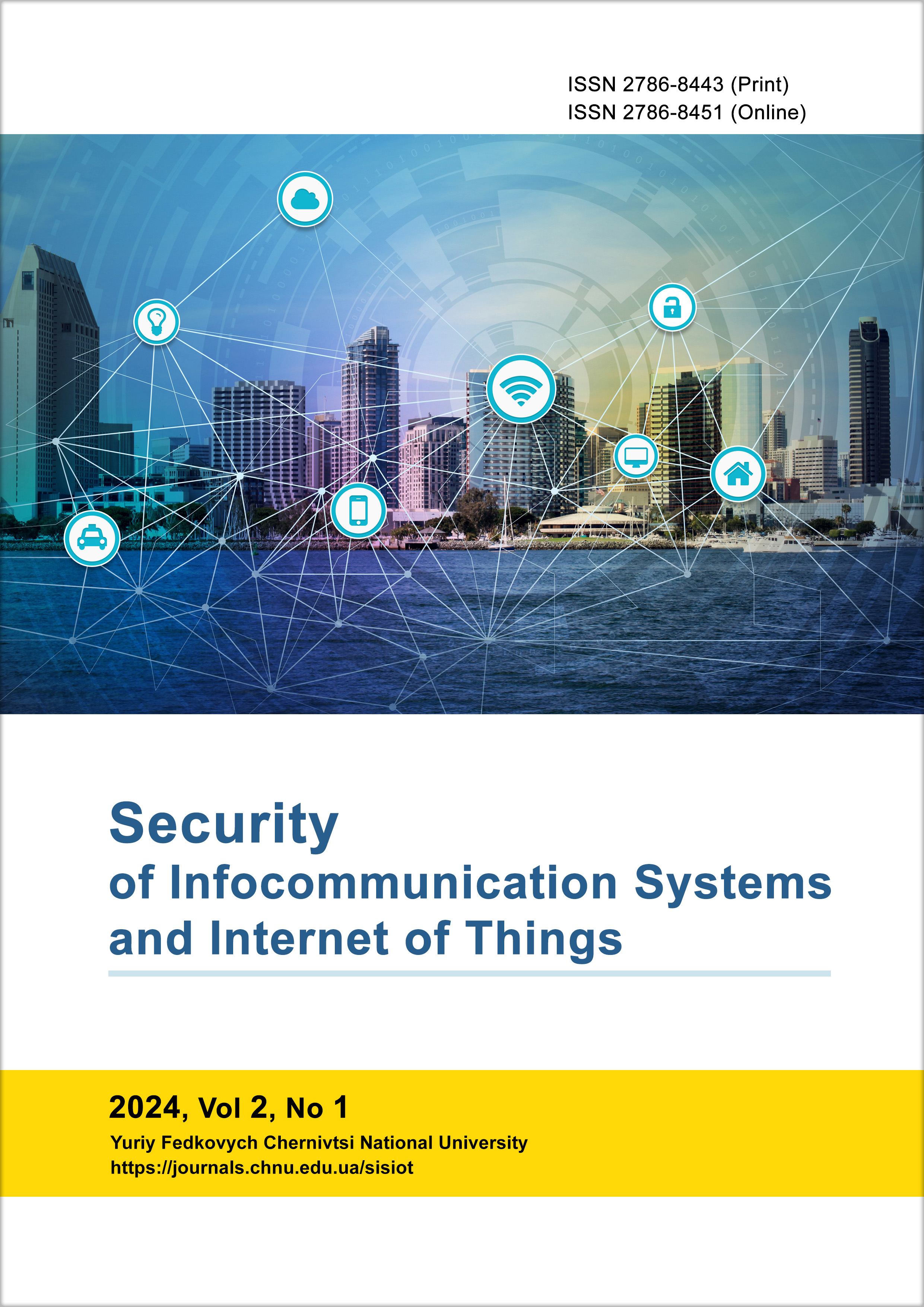Research the Level of Chaotic and Reliability in Webcam-generated Random Number Sequences
DOI:
https://doi.org/10.31861/sisiot2024.1.01004Keywords:
software engineering, chaos, crypto-resistance, software reliability, random number generatorAbstract
Engineering and software solutions in the sphere of software engineering, in particular cryptography, constantly require the use of random sequences in their algorithms. Usually, standard methods of frameworks, software platforms, libraries and programming languages do not provide the necessary level of randomness of generated number sequences. Basically, the randomness of software generators of random sequences is based on a value of a certain system parameter, for example, the value of the current date and time. It is obvious that with simple cyber-attacks it is possible to put the crypto-resistance of the system at risk. To solve this problem, the property of the webcam to generate the same image from a state frame is used. It is shown that the fact of changing values of illumination created by pixels differs by at least 63% for two consecutive frames 100 milliseconds gap in complete darkness, the level of the avalanche effect exceeds the crypto-resistance requirement by 13%. Thus, we can talk about a high level of chaos and randomness of the generated numerical sequences. Frame generation was carried out both in complete darkness with an illumination of 10-4 lux, and in a uniformly illuminated (200 lux) white surface. Testing the camera under extreme conditions gives a complete picture of the unpredictability and chaos in the generation of random sequences. It is hypothesized that this approach theoretically allows a generation of random number sequences at a speed of 1.25 Gbit/s, and a mixed software-hardware solution is able to provide up to 10 Gbit/s. The approach built on this property of a webcam can provide a way to solve the problem of designing an affordable low-cost, crypto-resistant high-speed hardware random number generator in laboratory conditions without the involvement of a special equipment.
Downloads
References
UKAZ PREZYDENTA UKRAINY №37/2022 “Pro rishennia Rady natsionalnoi bezpeky i oborony Ukrainy vid 30 hrudnia 2021 roku "Pro Plan realizatsii Stratehii kiberbezpeky Ukrainy". URL: https://www.president.gov.ua/documents/372022-41289. [in Ukrainian]
H. Fukś, “Four State Deterministic Cellular Automaton Rule Emulating Random Diffusion,” In: Chopard, B., Bandini, S., Dennunzio, A., Arabi Haddad, M. (eds) Cellular Automata. ACRI 2022. Lecture Notes in Computer Science, vol. 13402, 2022. Springer, Cham. https://link.springer.com/chapter/10.1007/978-3-031-14926-9_13.
Dobrovolsky, Y. "Development of a Hash Algorithm Based on Cellular Automata and Chaos Theory." Eastern-European Journal of Enterprise Technologies, 5/9 (113) 2021. Р. 48-55. DOI: 10.15587/1729-4061.2021.242849 https://journals.uran.ua/eejet/article/view/242849/241487.
A. Cicuttin, L. De Micco, M. L. Crespo, et al., “Looking for Suitable Rules for True Random Number Generation with Asynchronous Cellular Automata,” Nonlinear Dynamics, vol. 111, pp. 2711-2722, 2022. https://doi.org/10.1007/s11071-022-07957-8.
L. Li, Y. Luo, S. Qiu, et al., “Image Encryption Using Chaotic Map and Cellular Automata,” Multimed Tools Appl, vol. 81, pp. 40755–40773, 2022. https://doi.org/10.1007/s11042-022-12621-9.
Asia Othman Aljahdal, “Random Number Generators Survey,” International Journal of Computer Science and Information Security (IJCSIS), Vol. 18, No. 10, October 2020. [Online]. Available: https://zenodo.org/records/4249407.
F. Martinez, “Attacks on Pseudo Random Number Generators Hiding a Linear Structure,” in Topics in Cryptology – CT-RSA 2022, S. D. Galbraith, Ed. Cham: Springer, 2022, vol. 13161, Lecture Notes in Computer Science. [Online]. Available: https://doi.org/10.1007/978-3-030-95312-6_7.
Class SecureRandom. All Implemented Interfaces. URL: https://docs.oracle.com/javase/8/docs/api/java/security/SecureRandom.html.
M. Cornejo, S. Ruhault, “(In)Security of Java SecureRandom Implementations,” Journées Codage et Cryptographie, 2014. [Online]. Available: https://www-fourier.ujf-grenoble.fr/JC2/exposes/ruhault.pdf.
Ostapov, S.E., Dobrovolskyi, Yu.H. "Kvantova informatyka ta kvantovi obchyslennia." Chernivtsi: ChNU, 2021. - 99 s. https://archer.chnu.edu.ua/xmlui/handle/123456789/2830. [in Ukrainian]
B. Yan, Z. Tan, S. Wei, H. Jiang, W. Wang, H. Wang, et al., "Factoring Integers with Sublinear Resources on a Superconducting Quantum Processor," arXiv, vol. 2212.12372v1, Dec. 2022. [Online]. Available: https://arxiv.org/pdf/2212.12372.pdf.
Seongmo Park, Byoung Gun Choi, Taewook Kang, Kyunghwan Park, Youngsu Kwon, Jongbum Kim, “Efficient Hardware Implementation and Analysis of True Random-Number Generator Based on Beta Source,” ETRI, Volume 42, Issue 4, Special Issue on SoC and AI Processors, August 2020, Pages 518-526. [Online]. Available: https://onlinelibrary.wiley.com/doi/full/10.4218/etrij.2020-0083.
V. Barannik, S. Sidchenko, N. Barannik, and A. Khimenko, "The method of masking overhead compaction in video compression systems," Radioelectron. Comput. Syst., no. 2, pp. 51-63, 2021. [Online]. Available: https://doi.org/10.32620/reks.2021.2.05.
S. Yevseiev, O. Milov, N. Zviertseva, O. Lezik, O. Komisarenko, A. Nalyvaiko, V. Pogorelov, V. Katsalap, Y. Pribyliev, and I. Husarova, "Development of the concept for determining the level of critical business processes security," East.-Eur. J. Enterp. Technol., vol. 1, no. 9(121), pp. 21–40, 2023. [Online]. Available: https://doi.org/10.15587/1729-4061.2023.274301.
Agata Kaźmierczyk, Andrzej Ł. Chojnacki, Kornelia Banasik. "Pseudorandom Number Generators as Applied in Reliability Analysis." Kielce University of Technology, Faculty of Electrical Engineering, Automatic Control and Computer Science, Department of Power Engineering, Power Electronics and Electrical Machines, doi:10.15199/48.2022.12.44. [Online]. Available: http://pe.org.pl/articles/2022/12/44.pdf.
V. Barannik, N. Barannik, and O. Slobodyanyuk, "Indirect information hiding technology on a multiadic basis," Informatyka, Automatyka, Pomiary w Gospodarce i Ochronie Środowiska, vol. 11, no. 4, pp. 14–17, 2021. doi:10.35784/iapgos.2812.
V. Barannik, N. Barannik, O. Ignatyev, and V. Himenko, "Method of indirect information hiding in the process of video compression," Radioelectronic and Computer Systems, vol. 0, no. 4, pp. 119–131, 2021. doi:10.32620/reks.2021.4.10.
S. Ostapov, B. Diakonenko, M. Fylypiuk, K. Hazdiuk, L. Shumyliak, and O. Tarnovetska, "Symmetrical cryptosystems based on cellular automata," International Journal of Computing, vol. 22, pp. 15–20, Mar. 2023. https://doi.org/10.47839/ijc.22.1.2874.
R. Li, "A true random number generator algorithm from digital camera image noise for varying lighting conditions," in SoutheastCon 2015, Fort Lauderdale, FL, USA, 2015, pp. 1–8. doi: 10.1109/SECON.2015.7132901. Available: https://ieeexplore.ieee.org/document/7132901.
"Webcam-capture Resolution," GitHub. [Online]. Available: https://github.com/sarxos/webcam-capture/blob/master/webcam-capture/src/main/java/com/github/sarxos/webcam/WebcamResolution.java.
L. Afflerbach, "Criteria for the assessment of random number generators," Journal of Computational and Applied Mathematics, vol. 31, no. 1, pp. 3–10, 1990. doi: 10.1016/0377-0427(90)90330-3.
Published
Issue
Section
License
Copyright (c) 2024 Security of Infocommunication Systems and Internet of Things

This work is licensed under a Creative Commons Attribution 4.0 International License.









